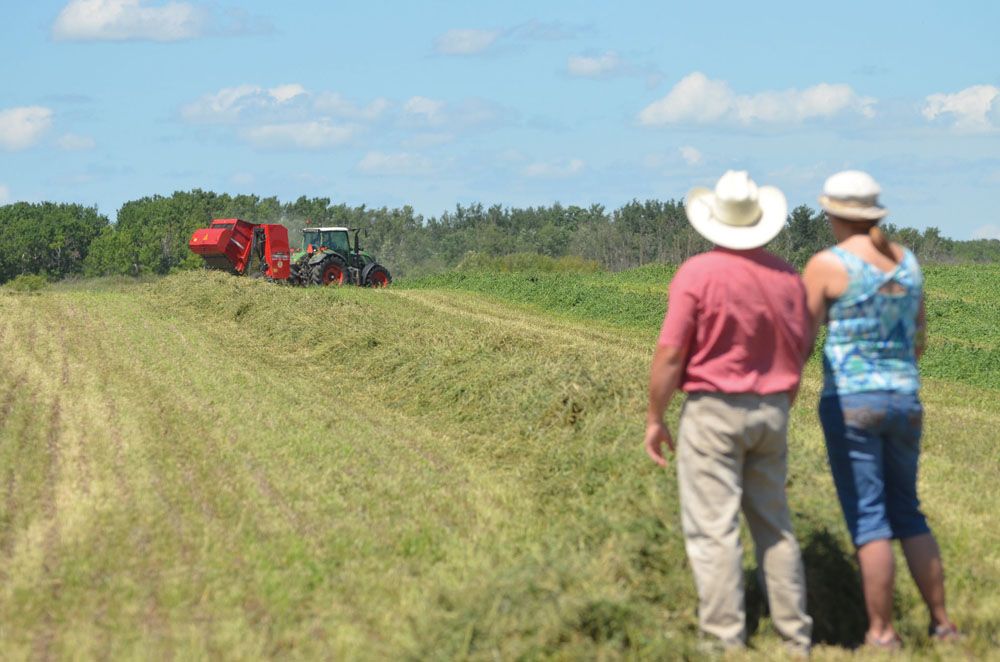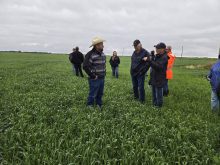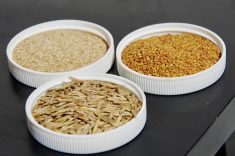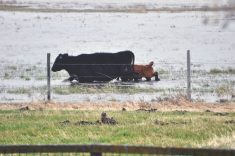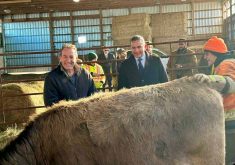Hay Day has a new home.
The annual Manitoba Agriculture event was held for the first time at the Manitoba Beef and Forage Initiative’s (MFBI) Brookdale site after two years in participating farmers’ fields.
It attracted more than 100 producers seeking information on how to produce top-quality hay every season and featured extension specialists from across the province.
“We are lucky enough to have this facility here and this is the first field day that we have had producers come,” said Pam Iwanchysko, farm production extension specialist with Manitoba Agriculture. “I am hoping that we can show some of our efforts today that we have been working so hard at over the past year.”
The day’s presentations focused on how to harvest high-quality hay, fertility tips for optimum forage production and equipment demonstrations of various makes of central pivot disc mowers and balers.

Experts on hand discussed the importance of cutting hay at the proper time.
“The quality of alfalfa varies a lot with the timing of cutting,” said Tim Clarke, a range and pasture extension specialist with Manitoba Agriculture. “What is most noticeable is that the forage digestibility decreases with time. So, the earlier we cut, the more digestible the forage and we end up with higher energy and higher protein in the baled product.”
Farmers are often tempted to wait to cut to acquire high yields, said Ray Bittner, a Manitoba Agriculture livestock extension specialist. However, he said that is often not the best way for a producer to get the most out of their hay stand.

“By waiting for increased yields, you may not be rewarding yourself as much as you think,” Bittner said. “Yes, you have lots of bales. But your dry matter digestibility is dropping, so are you really getting more? You may be able to take the crop earlier, when the forage yield is lower, and get just as many mouthfuls of nutrition as by waiting and getting the higher yield.”
When cutting, Clarke recommends cutting alfalfa/grass at about three to five inches in order to condition it properly so that the stems kink every two or three inches.
Forage producers were also warned to avoid cutting during the critical fall rest period.
“We recommend not cutting the hay during the critical rest period from August 20 until you get a -4 C frost. During that time frame you are putting your crop at risk for winterkill,” Clarke said.
He also suggests that forage quality can be better with a wider swath, as more of it is exposed to light allowing it to dry down faster.
“The quicker we can get our plants to dry down to where we can bale them, the more energy we are going to have in the stored hay afterwards,” Clarke said.

Optimum baling time is between 14 to 18 per cent moisture, or lower for larger bales.
Clarke warns that raking and storage can play a role in dry matter loss, recommending to try and set the rake so that it does not touch the ground and store bales on as dry ground as possible, preferably with roof cover.
The use of bale wraps was discussed and according to Bittner, they can certainly be beneficial in keeping bale temperatures down and reducing mould, but only if you are applying enough plastic.
“When you go with a very thin layer of plastic, your heat definitely still generates. You may have the bale covered but it is still heating up,” Bittner said. “The more wraps you put on, the cooler the temperatures stay. When the temperatures drop, your quality is going to be way better and you are going to be burning off a lot less energy. So, don’t scrimp on plastic.”
Read Also

Pig transport stress costs pork sector
Popular livestock trailer designs also increase pig stress during transportation, hitting at meat quality, animal welfare and farm profit, Agriculture and Agri-Food Canada researcher says






